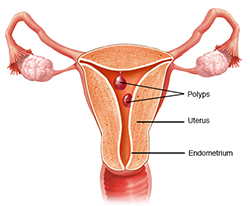ENDOMETRIAL AND CERVICAL POLYPS (Part One)

1 - ENDOMETRIAL POLYP
General
An endometrial polyp is one of the most common causes of abnormal genital bleeding in women in pre and postmenopause.
Most of them are benign in nature but malignancy can occur.
The prevalence varies from 10-40% in women with bleeding and 12% in routine examination and asymptomatic forms.
Malignancy varies from 0.8% - 8%.
Studies have shown an increase in the prevalence of pre-malignant and malignant polyps in women over 60 years, postmenopausal, and those with risk factors such as: obesity, hypertension, diabetes mellitus, and tamoxifen treatment.
The detection percentage has increased due to the increased use of ultrasound, hysteroscopy, hysterosalpingography.
Histopathology
An endometrial polyp is a localized hyperplastic growth of glands and endometrial stroma with a vascular structure that is attached to the surface of the endometrium in the form of a peduncle. They contain varying amounts of stroma, blood vessels covered by a multilayer epithelium. Vessels are more often found in large polyps. Smooth muscles may also be present.
Varies in diameter from a few mm to several cm.
They develop anywhere in the uterine cavity.
They vary in number from one to several.
They can be pedunculated or flat. Pedunculated polyps can protrude into the vagina through the cervix.
Pathogenesis
There are several molecular mechanisms that play an important role in the development of endometrial polyps.
- monoclonal endometrial hyperplasia
- overexpression of endometrial aromatase
- genetic mutations
Symptoms
- Asymptomatic
- Irregular bleeding
- Intermenstrual bleeding
- Menorrhagia
- Postmenopausal bleeding
- Dysmenorrhea (polyp protrudes from the cervix)
Cause
The cause is unknown, however, there is an increase in response to circulating estrogens. During a menstrual cycle, the increased level of estrogens favors an overgrowth of the endometrium beyond the normal level leading to the formation of the polyp.
Risk factors
- Obesity
- Hypertension
- Previous history of cervical polyp
- IUD with levonorgestrel
- Tamoxifen treatment
- Hormone therapy
Diagnosis
- Transabdominal and transvaginal ultrasound
- Dilation and curettage
- Hysteroscopy is one of the standard examinations for the assessment and resection of the endometrial polyp. It allows the complete removal of the lesion and biopsy of suspected areas in the adjacent endometrium.